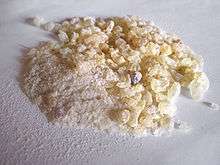Dammar gum

Dammar gum, or damar gum, is obtained from the Dipterocarpaceae family of trees in India and East Asia, principally those of the genera Shorea, Balanocarpus or Hopea. Most is produced by tapping trees; however, some is collected in fossilised form from the ground. The gum varies in colour from clear to pale yellow, while the fossilised form is grey-brown. Dammar gum is a triterpenoid resin, containing a large number of triterpenes and their oxidation products. Many of them are low molecular weight compounds (dammarane, dammarenolic acid, oleanane, oleanonic acid, etc.), but dammar also contains a polymeric fraction, composed of polycadinene.[1]
Uses
Dammar is used in foods, as a clouding or glazing agent, and in incense, varnish and other products. Dammar varnish, made from dammar gum mixed with turpentine, was introduced as a picture varnish in 1826;[2] commonly used in oil painting, both during the painting process and after the painting is finished.[3]
Dammar crystals are also dissolved in molten paraffin wax to make batik, to prevent the wax from cracking when it is drawn onto silk or rayon.
Dammar resins were often used in the past to caulk ships, frequently together with pitch or bitumen.[4]
The name is a Malay word meaning ‘resin’ or ‘torch made from resin’.
There are two further types of dammar, besides the gum:
- Mata kucing (‘cat's eye’) is a crystalline resin, usually in the form of round balls.
- Batu (‘stone’) is stone or pebble-shaped, opaque dammar collected from the ground.
Material safety
Physical data
- Appearance: white powder
- Melting point: approx. 120 °C
- Density: 1.04 to 1.12 kg/m³
- Refractive index: approx. 1.5
- CAS number: 9000-16-2
- EINECS: 232-528-4
- Harmonised Tariff: 1301-90
Stability and toxicity
The gum is stable, probably combustible and incompatible with strong oxidising agents. Its toxicity is low, but inhalation of dust may cause allergies.
See also
References
- ↑ Scalarone, D.; Duursma, M.C.; Boon, J.J.; Chiantoire, O. MALDI-TOF mass spectrometry on cellulosic surfaces of fresh and photo-aged di- and triterpenoid varnish resins. J. Mass. Spec. 2005, 40, 1527-1535. doi:10.1002/jms.893
- ↑ William Theodore Brannt (1893). Varnishes, lacquers, printing inks and sealing-waxes: their raw materials and their manufacture. H.C. Baird & Co. p. 168.
- ↑ Mayer, Ralph (1991). The Artist's Handbook of Materials and Techniques (5th ed.). Viking Adult. ISBN 0-670-83701-6.
- ↑ Burger, P.; Charrié-Duhaut, A.; Connan, J.; Flecker, M.J.; Albrecht, P. Archaeological resinous samples from Asian wrecks: Taxonomic characterization by GC–MS. Analytica Chimica Acta. 2009, 648, 85-97. doi:10.1016/j.aca.2009.06.022